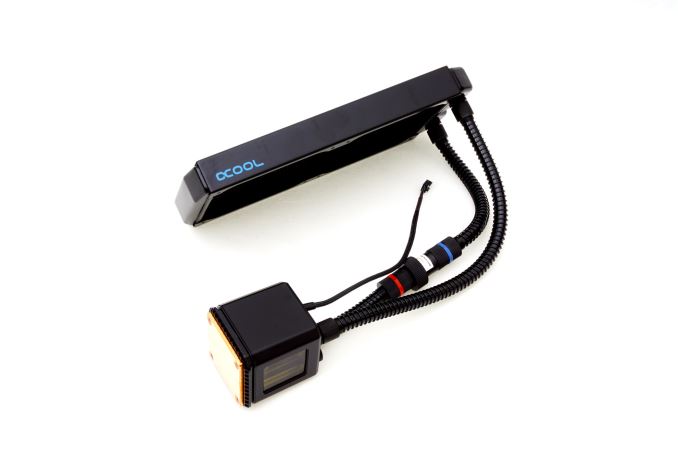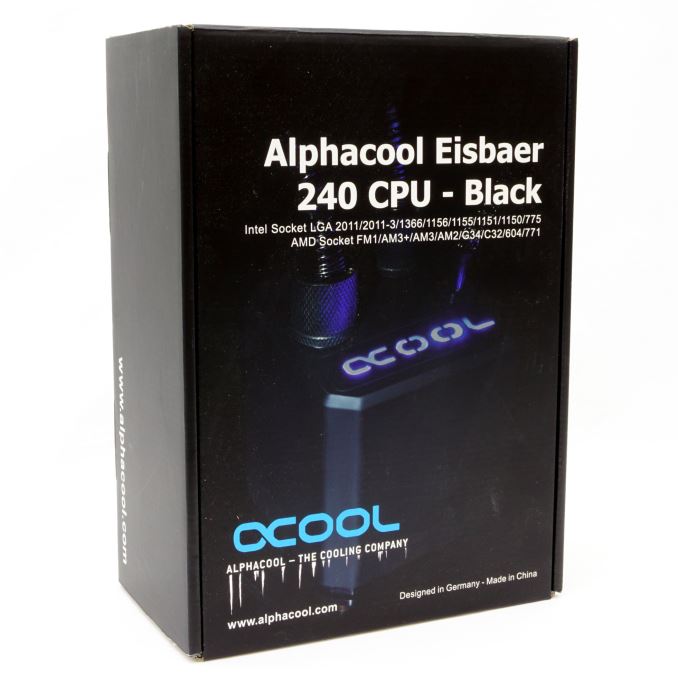The Alphacool Eisbaer 240 CPU AIO Liquid Cooler Review
by E. Fylladitakis on August 1, 2016 9:00 AM EST- Posted in
- Cases/Cooling/PSUs
- AIO
- Water Cooling
- Cooler
- Alphacool

When liquid cooling became a trend in the 90’s, many companies were founded focused on the design and supply of PC-specific liquid cooling systems. One of these companies was Alphacool, a German manufacturer that diversified into producing liquid cooling systems for industrial and medical applications as well.
Introduction
Perhaps the biggest issue of liquid cooling is complexity, requiring quite a bit of extra effort and attention from the user. For custom loops this was certainly true, even when complete kits were supplied by most manufacturers, as the installation alone is much more complex than that of a simple air cooler. The relative safety and simplicity of all-in-one (AIO) liquid cooling systems does lure those who want a liquid-based cooler with the installation straightforwardness of an air-based cooler. However, AIO solutions are relatively inflexible, and some hardly perform better than high end air-based solutions.
In this review we are having a look at Alphacool’s latest product, the Eisbaer. The Eisbaer, which stands for “polar bear” in German, is a modular AIO liquid cooler that Alphacool designed for those that wish to combine performance and simplicity with future upgrades and flexibility. Alphacool has designed four versions of the Eisbaer that all share the same block/pump assembly but have different radiators and fans. The Eisbaer 120, 240 and 360 come with one, two and three 120 mm fans respectively, while the Eisbaer 280 comes with two 140 mm fans. For the means of this review, Alphacool supplied us with the Eisbaer 240, the dual 120 mm fan version. Although the concept of modular AIO liquid coolers is not new, Alphacool’s liquid cooling parts have had a good reputation, leaving us curious about how their first AIO liquid cooler will perform.
Packaging & Bundle
Alphacool supplies the Eisbaer in a dark cardboard box with relatively simple artwork printed on it. It is very sturdy and the cooler is protected inside a cardboard shell and covered in nylon bags, providing more than enough protection during transport.
The bundle accompanying the Eisbaer 240 is almost typical and limited to the necessary mounting hardware, two “Eiswind” 120 mm fans, an adapter for connecting both of the fans onto one 4-pin header and two doses of thermal compound. It is interesting to point out that the thermal compound is Gelid GC Extreme, a relatively premium thermal paste. The Eiswind fans are PWM compatible, with a sleeve bearing engine and a maximum speed of 1700 RPM.












69 Comments
View All Comments
Death666Angel - Tuesday, August 2, 2016 - link
Totally. liquid cooling in the end functions the same way as air cooling, since the water has to be cooled down by air cooling. It only functions as a quick way to get rid of the heat at the source, but then you need radiators (like traditional heatsinks have directly on the CPU/GPU) to get rid of the heat from the water. But since custom liquid cooling is not restricted to the space around the CPU socket or on the graphics card, you can have much more cooling area. I myself have a 2x2x120mm radiator and another 200x200mm radiator, that is probably a bit more area than a high end air cooling CPU and GPU HSF have combined. But I also have that installed in a mATX case. People who go higher end have several 280, 360 radiators installed in their cases or they go 9x120 or 9x140 with external radiators. That is much more cooling area than traditional socket and graphics card coolers can provide.retrospooty - Tuesday, August 2, 2016 - link
You can... But you need to find a quiet water pump. It may also be quiet day one and get louder over time. The other thing is the water pump and the power control behind it introduce 2 additional potential fail points... It just doesn't make a whole lot of sense if building a new system today. Skylake CPU's are very cool and fan noise on them can be zero or near zero even if you are overlocking the crap out of it.Death666Angel - Tuesday, August 2, 2016 - link
"custom loop cool" "Skylake CPU"No one in their right mind uses a custom liquid cooling solution just for the CPU. And since modern rigs can still easily produce 400 to 500W of excess heat if overclocked to their maximum (and that is just for the entry level enthusiast gear), water cooling still makes sense in those cases.
Also, pumps have been nearly silent for years and tests have shown that high water flow isn't really necessary for good cooling temperatures. So something like a throttled Phobya DC12-220 will provide enough power to give you 80l/h at throttled speeds with a CPU+GPU+2 radiators setup and run silently if you decouple it from the case and dampen it with rubber.
How does a WC setup get louder over time and air cooling does not? Mine does get slightly worse performance after a few months of not cleaning the radiator fans. But the same is true of air cooling. That's what a vacuum and compressed air is for. If you are talking about having gunk in your coolers, that shouldn't happen if you set it up right.
I've had a custom WC setup for nearly 6 years now, I've changed the graphics cards one and the cpu/MoBo once and cleaned everything when I did that. First time I had some gunk in the coolers which reduced the flow rate (I didn't use the right ratio for the water additives). Second time I had some gunk but no reduction in flow rate. Now I've not touched it for over a year and the flow rate is steady.
retrospooty - Tuesday, August 2, 2016 - link
I would agree, but it is said in relation to the article above on the Eisbaer 240 "CPU" AIO Liquid Cooler.Death666Angel - Tuesday, August 2, 2016 - link
"Can you make a custom loop cool better AND be quieter than a high end air tower?"Just because it is posted below this review, does not mean you should ignore what he actually asked.
retrospooty - Tuesday, August 2, 2016 - link
I am not sure what you are getting at... I answered his question. He said nothing about a video card, you said that after my post.HomeworldFound - Tuesday, August 2, 2016 - link
An Aquacomputer D5 paired with an Aquaero 6 and an Aqualis reservoir is silent. On my 5930k I can turn the pump down to 25% and my fans down to 500rpm and you can't hear a thing, it's quieter than my fridge freezer near the PC which is further away. I do have 2x 480mm 60mm radiators though.HomeworldFound - Tuesday, August 2, 2016 - link
and 980 SLI. Building a new rig now.ikjadoon - Tuesday, August 2, 2016 - link
Dude, you can buy an AIO CLC that does that, LOL.http://www.hardocp.com/article/2016/02/11/arctic_c...
zodiacfml - Tuesday, August 9, 2016 - link
I used to follow every and latest cooling tech throughout the years. For desktop cooling, it is as simple as having more surface area, radiator or heatsink. You can also effectively have a larger surface area there's a faster flow of air using faster, louder fans. For your question, having a large radiator beats a smaller air solution.These days though, it doesn't mean much anymore as Intel CPUs are focused on lower TDP's.
AIO coolers should focus their money and energy now on GPUs as it still has huge cooling requirements.